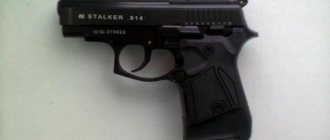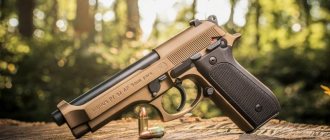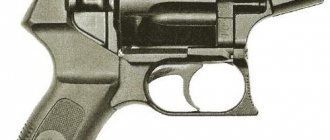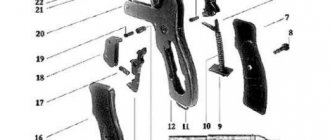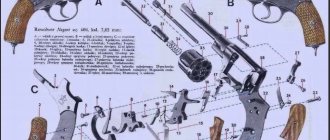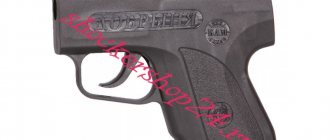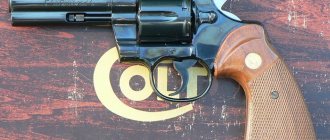As you know, a signal revolver is quite different from a firearm. The first thing to note is that it is not designed to ensure security. His main responsibilities include creating a sound effect. It can be used in different ways in different situations. Alternatively, a signal revolver is used to scare away dogs. At the same time, he can always help a person in a difficult life situation, simply by attracting the public’s attention with a loud sound.
The general public on television quite often sees a pistol of this type at sporting events. In this situation, he gives a start signal to all participants. According to current legislation, any adult can purchase such a revolver without any permitting documents. In this regard, signal modifications are much simpler than gas weapons, as well as traumatic weapons.
Important characteristics of revolvers
The main parameters of signal revolvers include the bullet's flight range. The material from which it is made is also taken into account. Unlike firearms, shooting accuracy does not matter. Additionally, the buyer must take into account the dimensions of the revolver. In terms of weight, it must also be comfortable.
Revolver handles are quite different in shape, but a rubber gasket must be present. Lastly, the model's configuration is considered. For convenient transportation, the manufacturer usually provides a case. Also, the buyer must have a document for the product, which indicates that the model is a signal model and does not require permission.
History of the creation and use of starting pistols and revolvers
No historian can reliably say when starting pistols or revolvers appeared; not a single document that has survived to our time speaks about this. The starting weapon can be any firearm (and not only firearms). The age of starting pistols is comparable to the age of any firearm that can be called a pistol. After all, the properties of such weapons do not say that the starting pistol must be loaded with a blank cartridge, or use some other ammunition that is not capable of causing damage.
That is, any pistol (revolver) has the right to be called a starting pistol if it is used to start some kind of competition.
Recently, classic starting pistols have been replaced by special electronic devices that are more reliable, eliminate the possibility of misfires, do not depend on the reaction of the person starting the stopwatch, and provide accurate measurement of the results of the competition. Over time, they will significantly displace starting pistols, and perhaps completely replace them.
Parameters of the MP-371 pistol
The MP-371 signal pistol is only 143 mm long with a height of 105 mm. The total weight of the model when charged is 450 g. The magazine in the MP-371 modification is designed for seven rounds (plus one of them in the chamber). There is a bar and a front sight as an aiming device. They cannot be adjusted in this modification. The caliber of the cartridges is 6 mm. The signal lift height is 120 m, and the bullet flight range is 150 m.
The handle of the MP-371 pistol in this case is made of plastic by the manufacturer. In turn, the barrel is made from a metal alloy. It can withstand quite a lot of maximum pressure, despite its small thickness. In total, the MP-371 signal pistol has 47 parts and components. The standard kit includes a case for transporting the model, as well as documentation for the product. Additionally, the user will be able to find a brush, which is necessary for cleaning the barrel after using the gun.
Signal weapons and their capabilities
Let us consider the emergence and development of precisely those pistols (revolvers) that were originally intended only for the start of sports competitions or for giving signals. Its purpose, rules for handling it, its models, characteristics, advantages and disadvantages of some models over others.
The purpose of the starting weapon
The main purpose of the starting pistol is to give a signal for the start of a sports competition. The signal is a loud sound, flash or smoke occurring at the moment of the shot. Most often, the start is made precisely by a flash, and not by sound, since the speed of sound propagation is much lower than the speed of light.
But, in addition to its main purpose, the starting (signal) weapon is also used for other purposes. Nowadays, it is purchased in collections and used for self-defense. It can be used to send a distress signal and indicate your location in the forest, at sea, and in other situations where it is necessary to attract attention. Therefore, it would be useful for tourists, climbers, fishermen, and others who spend their free time away from civilization to have it in their arsenal. In general, a signal weapon can be used in completely different situations, even if this is not specified in the instructions for the pistol or revolver.
Starter weapon for self-defense
The flare gun is not capable of causing any damage. But this does not mean that it is useless for self-defense. Some models of starting pistols are replicas of military weapons, and the mere sight of them can cause an attacker to abandon his plans. Few people can distinguish the sound and flash produced by a pistol when fired from the action of a military weapon. And this will become another psychological barrier for the criminal. In addition, self-defense also involves actions against aggressive animals, and for many of them, the sound of a shot and a flash will become an obstacle to attacking the owner of the starting pistol.
Carrying a signal weapon in the city
Since the very title of the object of our article contains the word “weapon”, let us turn first of all to the basic law of our country, which regulates all legal issues in relation to signal pistols - Federal Law of December 13, 1996 N 150-FZ “On Weapons”, in its last editorial office (dated 06/28/2021).
The right to purchase weapons by citizens of the Russian Federation
“Citizens of the Russian Federation have the right to purchase gas pistols, revolvers, and signal weapons on the basis of a license.”
That is, a signal weapon is not a toy, and its acquisition, carrying and use is regulated by Russian legislation.
“Products structurally similar to weapons, signal pistols, revolvers with a caliber of no more than 6 mm and cartridges for them, which cannot be used as firearms, firearms of limited destruction and gas weapons, are purchased without a license and are not registered” Procedure for conducting expert research in order to determine the possibility of using products structurally similar to weapons, signal pistols and revolvers with a caliber of no more than 6 mm, cartridges for them as firearms, firearms of limited destruction and gas weapons, it is established by the federal executive body exercising the functions of developing and implementing state policy and legal regulation in the field of internal affairs.”
From the above excerpts from the Federal Law “On Weapons” it is clear that signal (starting) pistols with a caliber of less than 6mm are not subject to licensing, but be prepared to schedule an examination if it is possible to use them as a firearm, or conduct an examination in advance. Signal (starting) weapons with a caliber of more than 6 mm must undergo a licensing procedure.
The main advice is that if you decide to purchase a signal (starting) weapon for personal use, consult the LRO of the Russian Guard at your place of residence.
What is interesting about the LOM-S revolver?
The signal revolver LOM-S has a length of 202 mm and a height of 120 mm. The weight of the model when charged is 650 g. The drum in this case is designed to hold 8 rounds. A bar and a front sight are used as an aiming device without the possibility of adjusting them. The bullet's flight range is 170 m. There is a rubber pad on the handle.
The body of the LOM-S revolver is made of an alloy of steel and copper. It can withstand quite a lot of pressure. The rod in this modification is manufactured hollow at the factory. In this regard, the socket for it is made in the form of a blind bushing. The trigger release is quite smooth. The barrel of the signal revolver LOM-S is of a solid cast type.
Revolver-revolver "Thunder"
The indicated signal revolver-revolver weighs 550 g when loaded and has a length of 205 mm. The caliber of this modification is 6 mm. The height of the signal rise is at around 200 m. The handle of the Grom revolver revolver is manufactured at the factory with a rubber lining. The rod in this modification is hollow. The cocking of the device is quite convenient.
The safety in this case blocks the trigger. The barrel of the Grom revolver is very thin and has no rifling. The bullet entrance is provided in the shape of a truncated cone. The trigger of the revolver is equipped with a matchlock. The cocking mechanism is made without the participation of an extractor. Cartridges for the Thunder revolver are used only with a cardboard sleeve.
Cartridges used in signal pistols
There are many different cartridges used in signal (starting) weapons. They differ in type, caliber, purpose and other parameters. For signal pistols converted from military weapons, blank cartridges produced for these types of pistols (revolvers) are used. Some domestic starting pistols use Zhevelo primers. Special cartridges for signal weapons are also produced. Depending on their purpose, cartridges are divided into light, light and sound, noise, lighting (parachute and non-parachute), and smoke.
The main thing is to remember safety precautions when using a starting (signal) weapon. This is not a military weapon, but careless and illiterate handling of it can also lead to unpleasant consequences.
Nagan R-2
The R-2 signal revolver weighs 600 g and is 320 mm long. The chamber in this case consists of four cones. The barrel is classified as smooth without a muzzle brake. The R-2 Nagant has a bullet range of 200 m. In total, the manufacturer provides 42 units and parts in the modification. The chamber of the R-2 revolver is made in the form of a blind bushing, and at the end there is a rod. The trigger release is quite smooth. The body is manufactured at the factory from copper alloy and also from steel. There is a socket for a replaceable chamber. It is possible to convert a signal revolver into a small one.
Ecol revolvers
Ekol signal revolvers have a barrel size of 130 mm with a total length of 160 mm. The width of this modification is 35 mm, and the weight when charged is 500 g. A bar is used as an aiming device. The barrel in the Ecol revolver is made monolithic. The manufacturer always makes the handle with a rubberized gasket. The trigger mechanism in this case is provided without a blind hole. The bullet's flight range is 170 m. The Ecol signal revolver has a solid cast drum, and the rod in this modification is made hollow. The standard package does not include a case.
Characteristics of the MP-313 revolver
The MP-313 signal revolver weighs 450 g when loaded. The total length of this modification is 240 mm. The caliber of the MP-313 revolver is 9 mm. The height of the signal rise is around 200 m. In terms of noise level, this model does not differ from other modifications. The barrel of the revolver is classified as all-metal. The drum rotates on a rod with a plug. The trigger mechanism is not equipped with an extractor.
The bullet's flight range is 210 m. The body is made of aluminum alloy and steel. In total, the MP-313 signal revolver has 43 units and parts. The rod is equipped with a small plate at the end, and there is a hole behind the blind bushing. There is a rubber gasket on the handle. There is no way to adjust the sighting sight. The hammer in the MP-313 revolver is equipped with a safety lock. The standard package does not include a transport case. Conversion of signal revolvers to small size guns is carried out by replacing the firing pin.
Predecessor of TOZ 101
The predecessor of the TOZ 101 was the Soviet revolver TOZ TM 100 Skunk. I did not find any photographs or any descriptions of TOZ 100. So I would be grateful for information about the revolver.
On the basis of the TOZ 100, the TOZ 101 signal and gas revolvers were developed, followed by a more weakened model, produced at another RS-01 SKAT plant. But SKAT was also used for modifications, and in the end they made a completely toy RS22.
Revolver "Smersh RK-1" 5.6 mm
The 5.6 mm signal revolver is equipped with seven bullets. Its barrel is classified as all-metal, and there are only longitudinal riflings. The trigger is made of an open type and with a slide. A fuse is provided in this modification. The trigger release is quite smooth. The rod in the Smersh RK-1 revolver is hollow and has a special hole for it. At the end, the lock rests on a blind bushing. The noise level of the revolver is 200 dB. The bullet entrance is shaped like a truncated cone. The impact mechanism is installed with a silicon lock.
Parameters of the "Bluff" revolver 1920
The dimensions of the “Bluff” signal revolver are as follows: length - 204 mm, height - 109 mm, and width - exactly 30 mm. The model weighs 700 g when loaded. In total, the ram in the “Bluff” revolver is designed for seven rounds of 5.6 mm caliber. The flight range of the bullet is exactly 200 m, and the height of the signal rise is at the level of 180 m. The barrel in this case is made with a size of 120 mm. It is classified as rifled and has 16 turns.
The body of the Bluff revolver is made of an alloy of steel and copper. In turn, the handle is made with a plastic lining. The rod in the drum is hollow type. There is a special connector for it in the modification. Cocking the hammer is quite comfortable. The blind plug in the “Bluff” model is located in the rear part. The front sight is used as an aiming device. There is no way to adjust it in the revolver. Cartridges for the model are used only with a cardboard wad. The barrel is made quite thin, but overheating rarely occurs. Bullet stabilization is generally good due to the rifling. There is no muzzle brake in this modification, and the firing mechanism is made without a lock, but there is a safety lock in the revolver.
LiveInternetLiveInternet
EvilCluster
08-07-2014 21:31 RS-22. The famous stranger from the dashing 90s.
This time I want to talk about one revolver from my collection, the history of its production, notoriety and subsequent oblivion.
In the history of weapons there are a lot of samples that became known throughout the world and were in service with entire armies for many decades. But there are even more samples that turned out to be not very successful and have sunk into oblivion, remaining only in museums or private collections, as a monument to their time or some events in the life of the owner.
This is also in my collection. This is the RS-22 'GUARD' signal revolver. This model was not initially a masterpiece of weapons design. For example, if you compare the well-known Nagan revolver and the RS-22, it seems that it was this scanty silumin craft of our gunsmiths that was developed in 1895, and not the old Nagan.
But for me this revolver is special, since perhaps my passion for weapons began with it. And it was definitely the very first more or less serious weapon in my collection:
MODEL HISTORY
The RS-22 is known primarily for the fact that it is the first signal weapon freely sold in Russia. Yes, yes, that’s where it all started. Moreover, as far as I know, the first gas weapon in the line of the Izhevsk Mechanical Plant, RG-22, was manufactured precisely on its basis. Maybe, by the way, this is the first model of gas weapons in Russia: If anyone knows for sure, please write and we’ll add to the article together!
RS-22 stands for 'Starting Revolver'. Index 22 will probably remain a mystery. RG-22, respectively, 'Gas Revolver'.
According to the passport, 'The RS-22 "Guardian" signal revolver is designed to produce sound signals.'
The revolver was manufactured at the Izhevsk Mechanical Plant. This is indicated by the mark on the left side of the frame, a vertical arrow in a circle. Also below is the PCT conformity mark:
Mark of conformity for mandatory certification
If a product is subject to mandatory certification and a mandatory certificate of conformity has been issued for it, then the product is marked with the mark of conformity (PCT) of mandatory certification. This mark of conformity reflects information about the certification body that issued the certificate of conformity. The letter and numeric designation corresponds to the number of the certification body.
It is interesting that later these marks were stopped. At least on the RG-22 I saw there is no IzhMech mark. Are they embarrassed to indicate who gave birth to THIS?
As for the marks. On the right side of the barrel is the inscription 'GUARD', molded with the body in an unclear style font. The proper name of this weapon model.
On the right cheek of the handle there is a brass circle with some obscure symbol. Namely, the modern Izhevsk coat of arms, only one-color, without blacksmith's tongs and bunches of rowan. Underneath this is an even less clear inscription 'shield'. If anyone knows exactly what it is, please write and we'll add to the article together!
The pistol number, model and caliber were written on the end of the handle.
I also don't know the name of the constructor. It looks like this is an independent development of IzhMech. At least, I don’t know of its analogues among foreign models and, especially, among military weapons.
A link to a certain technical condition (TS) was found on the Internet, which could shed light on the history of the revolver:
Number TU 3-2573-92 Name Signal revolver “Guardian” model RS-22. Technical conditions. Effective from 04/20/1992 Pages 25 TU 3-2573-92 is located in the section Refereeing, information, research instruments and operational equipment for stadiums, sports grounds and other sports facilities - TU Catalog.
However, the document itself could not be found:
It is also known that there were several modifications of the revolver; more about them in the chapter 'Modifications'.
Interestingly, in 1993, a revolver cost 90,000 rubles (about 80USD at the exchange rate of those times) and was sold in hardware stores in packages like these.
The revolver was mass-produced from 1992 to 1996. After production of the RS-22 ceased, it was replaced by the RS-33, a more advanced starting revolver with self-cocking.
DEVICE
The body and barrel of the revolver are a single unit and are made of light alloy (silumin?) using precision casting. The body is painted with black paint, which is extremely unstable. Therefore, almost all revolvers that have survived to this day have an extremely “combat” shabby appearance. The trigger body is made in the form of a completely removable square frame with a “tail” for the mainspring and pusher. The trigger frame was inserted into the revolver body from above, through a slot above the drum. In this case, the “tail” of the frame with the spring entered the handle, and the square of the frame seemed to cover the revolver drum. Next, the frame was fixed with a screw at the back of the handle. This screw pressed the frame against the revolver body and fixed it in the desired position.
The frame itself is made of very thin and flimsy metal, more like thick tin. It is not the slightest difficulty to bend it with your fingers without any tools. More or less sufficient structural rigidity is achieved by the shape of a box-shaped frame, when everything is supported by stiffening ribs, and not by the strength of the material.
The trigger parts are made of steel, but again somehow weakened. There are dents on the trigger from mild side impacts, and the trigger itself leaves marks on the cylinder (if on the RG-22 with rimfire you pull the trigger without a cartridge in the chamber, the dent will be right on the edge of the chamber).
The design of the trigger is very simple, or rather simply primitive. It is single action (SAO) and the hammer must be manually cocked before each shot. Pulling the trigger with the hammer uncocked simply rotates the cylinder one round. When the hammer is cocked, the drum also rotates.
The trigger consists of only 12 parts.
1. Frame 2. Trigger 3. Trigger (SK) 4. Trigger pusher 5. Mainspring 6. Trigger spring 7. Pawl (drum pusher) 8. Pawl spring 9. Trigger axis, SK spring axis and pawls, SK axis 10. Dog hairpin
When cocking the hammer, the hammer acts on the pusher and compresses the mainspring. In this case, the trigger hook moves the trigger towards the handle. At the same time, the pawl, attached on a pin to the steering wheel, rises up, presses on the drum gear and turns it. The next cartridge is placed opposite the cocked hammer. The trigger hook engages with the SK hook. That's it, the revolver is cocked and ready to fire. After pressing the trigger, the hook is released from the cock, the pusher, under the influence of the straightening mainspring, presses one of the “teeth” (rear) on the trigger, turning it on the axis. After the hammer strikes the primer and the shot is fired, the front “tooth” of the pusher stops the hammer. The mainspring is completely decompressed, the pawl, under the influence of the spring, is retracted and lowered, the SK, under the influence of its spring, returns to its original state.
The pistol drum is fixed by a ramrod axle that fits into the ramrod tube under the barrel and holes in the trigger frame. To reload, the ramrod is removed from the ramrod tube, freeing the drum. The cleaning rod also serves as a screwdriver for disassembling the revolver.
Surprisingly, despite the unreliable materials, the revolver turned out to be quite durable in practice. Its service life is quite enough for a signal revolver, and many samples from the first years of production still, after 20 years, shoot properly. The main problems were related to the drum gears. Due to the weakened metal (the steel of the pawl is much stronger), it wears out and the drum does not turn completely. In this case, the cartridge does not stand opposite the firing pin and a misfire occurs. It is also not uncommon to find instances with a lost drum pawl - when removing the trigger frame for disassembly, the pawl tends to fly off under the influence of a straightened spring and get lost. However, the initial simplicity of the revolver design and the uncomplicated shape of many parts make it possible to re-manufacture almost any trigger part without special equipment. The revolver was also covered with low-quality paint, which began to mercilessly peel off after only a short period of use.
MODIFICATIONS
It is known that the revolver's passport has changed. First there was a faceless black and white passport.
Then a new one appeared, with runners of color on the cover.
The old-style passport is available here https://guns.allzip.org/topic/18/336613.html If anyone has a link to the new passport or scans of it, please send it.
It is possible that the new version of the passport appeared in connection with a modification of the device of the revolver itself, since a new part appeared in it. Due to numerous alterations of this revolver for a small-caliber 5.6mm rimfire cartridge (I will tell you about the alterations later), a pin was added in the barrel, similar to that on the RG-22.
The top of the pin is visible at the top of the barrel, not welded or ground in any way. The pin covers the barrel vertically, its lower part rests against the ramrod tube under the barrel.
Previously, there was no pin in the barrel at all. The early frame model, as previously mentioned, was square. And its front part blocked the barrel, preventing the bullet from being fired.
The new model has a pin; the trigger frame is now split and does not overlap the barrel, as on the RG-22.
The cheeks of the handle were also different. They were produced in two colors: bluish-gray and black. The cheeks themselves in both colors were made of plastic.
It is not known whether the different colors of the cheeks and the new modification with the pin were connected, who knows - write. What color are your cheeks and do you have a pin?
I do not know the date of modification with the pin.
It is also known that some models had threads in the barrel. A nozzle for launching rockets was screwed onto the thread. If anyone has a photo of such a nozzle, please send it. Separately, and how it looked on a revolver.
BAD REPUTATION
Some weapons have a double history. For example, the well-known pistol of the Second World War, the TT, first became famous as a weapon of fighters against fascism, a liberator pistol. And in the 90s, this pistol did not leave the pages of criminal chronicles, becoming the favorite weapon of hired killers in showdowns of that dark time:
It’s funny to compare the RS-22 with the legendary pistol, but its history in some ways duplicates the one described above. Appearing as a symbol of liberalism and a relaxation of government in terms of arms trafficking, it ended up as the civilian revolver most often converted into a criminal firearm.
'The ECC of the Ministry of Internal Affairs of Russia carried out an analysis of converted gas and signal weapons seized from illegal circulation in 1992 - 1999. and tested according to the federal bulletproof cartridge. As a result of the analysis, it was revealed that the following models of gas and signal weapons were most often subject to alteration: RS-22 “Guardian”, RG-22 revolvers, 6P42, 6P37, IZH-78, IZH-79 pistols, Walter “PP”, “PPK” .' (Kokin A.V. Measures to counter illicit trafficking of weapons in modern conditions and the role of forensic research methods in this direction // Forensic science. XXI century: Materials of a scientific-practical conference. M., 2001. T. 2. P. 233.)
Please note: the RS-22 is at the top of this low-esteem list. The simple design and ill-conceived system of protection against alteration did their dirty work.
Due to my line of work, I have access to court decisions on relevant criminal cases (open) and I would like to give several indicative excerpts from them:
:. In addition, at the same address, K. made changes to the trigger mechanism of the RS-22 signal revolver by adapting it for firing sports and hunting rimfire cartridges of 5.6 mm caliber using a muffler, which he made from tubes and played the role of a silent, flameless firing device for the RS-22 signal revolver. :. An RS-22 revolver with a silencer, converted by K. into a firearm, and knives by L., K. and B. were used to commit a robbery at I.’s apartment. July 19, 2007: THE SUPREME COURT OF THE RUSSIAN FEDERATION CASSATION DECISION dated June 1, 2010 N 43-O10-12
: While in the house of the named victims at the above address, at about 19:30 on December 3, 2008, continuing his criminal actions, K. pulled out a RS-22 Sentinel revolver from his holster, pointed it with the muzzle at F. and then at L ., while voicing death threats against them. The victims took the threat of murder realistically: SUPREME COURT OF THE RUSSIAN FEDERATION SUPERVISOR DECISION dated January 18, 2010 N 30-Dp09-8
:.Also, the pistol-revolver RS-22 01 N сА01 with three live cartridges of 5.6 mm caliber, seized from I., are ammunition suitable for shooting. The pistol-revolver is converted to fire 5.6 mm cartridges and is a firearm:. : So, I. did not deny that he purchased a pistol-revolver with live ammunition in October 2004 from his friend and kept them at home and carried them with him. On the day of the crimes against victims N. and S., a pistol with cartridges was with him, and from this pistol he fired fatal shots at the victims: SUPREME COURT OF THE RUSSIAN FEDERATION CASSATION DECISION dated April 24, 2006 Case No. 47-o06-10
: From the testimony of witness V. it follows that in the summer of 2005, in the courtyard of E.’s house, B. offered him to buy a weapon, explaining that the revolver fired live bullets. Since he had no money, they agreed that he would give it back later through E. After 3-4 days, he came to E., gave him “…” rubles, and the latter led him to the stoves near the house, from where he took out a package with a revolver and handed it over to him. He fired into the air and made sure the revolver was in good condition. On March 9, 2006, he voluntarily gave the revolver to the police officers, saying that it was in B.’s purse and, according to the seizure protocol, a “Guardian” model RS-22 revolver was seized from B., inspection of which revealed that there was a number on the base of the revolver handle “...” From the conclusions of the ballistic examination, it follows that the revolver seized from B. is a smooth-bore revolver of 5.6 mm caliber, homemade converted from a “Guardian” revolver, model RS-22, with the number “…”, domestically produced, by removing part of the front bearing plate frame, installing an insert barrel, drilling out the drum chambers and replacing the striker. Two of the three pieces of metal taken from A.’s corpse are parts of bullets from sporting and hunting cartridges of 5.6 mm caliber, standard for the TOZ-8 rifle, carbines, pistols, revolvers and combined shotguns of 5.6 mm caliber. The third piece does not have design features that would allow it to be classified as a specific type of bullet. The bullets taken from A.’s body could have been fired from a “Guardian” revolver, with the number “...”. SUPREME COURT OF THE RUSSIAN FEDERATION CASSATION DECISION dated January 14, 2008 N 48-007-91
:.an act of forensic ballistic examination stating that the bullets extracted from the corpses of K. and A. are components of 5.6 mm sporting and hunting cartridges. And they were shot from a smooth-bore homemade weapon; the fact of the discovery in the basement of F.’s house of two RS-22 revolvers with removable barrels and cartridges;: THE SUPREME COURT OF THE RUSSIAN FEDERATION CASSATION DECISION dated February 13, 2003 N 11-O03-07
Unfortunately, this bloody list can be continued for a long time...
However, most of the revolvers sold were still used for fun shooting in the air at barbecues and showing off in front of the opposite sex. The weapon also served its intended purpose. That is, the revolver was quite widely used as a starting revolver, for giving signals at various sporting competitions. There is evidence of almost 'combat' use of the RS-22:
'This summer, while rafting down the remote taiga river "Usa" (Kemerovo region), we very effectively preventively defended ourselves from bears with an RS-22 revolver. A couple of chews in the air and the bear stopped growling in the bushes and left.'
A kind of confirmation of people's love is the tuning that occurs (now we are not talking about criminal alterations) of this model by the owners. For a short silumin revolver with mediocre characteristics, this is an undoubted achievement. Here are some photos of such decorations:
So, the notoriety of the revolver will not change the fact that it was with the RS-22, the “people's scarecrow”, that the era of relative accessibility of civilian weapons to ordinary weapon lovers began. That is why I decided to talk about this revolver, the first in my collection:
When I was 12-13 years old, my uncle gave it to me as a toy. The revolver was already badly battered by life. The paint is missing, the frame is all chipped (has it been in acid or something?), the cheeks are of different colors, the trigger was also faulty. The revolver cocked, clicked the trigger, but the cylinder did not turn.
Despite this, the weapon was fascinating, it was too heavy for a toy and it emanated some kind of “realness”. I played with it for quite a long time. Then I tried to fix it, but nothing came of it and, having finally broken the revolver, I threw it into a box with old toys. And then I completely forgot about its existence.
I came across it again at a conscious age, sorting out personal belongings when moving to a new apartment in connection with my marriage. Since by this time I was already interested in weapons, the condition of the revolver was again inspected by an experienced eye.
The revolver itself, according to the number, is from 1994. Everything is sad with performance. It wasn't even MMG anymore, it was worse. What was missing was the mainspring, trigger pusher, pawl turning the drum, trigger springs and pawl spring. The trigger consisted of only two parts: the trigger and the trigger.
Frightened by the scale of the restoration work, I decided not to bother and put the revolver in the safe. The RS-22 again went into forced hibernation. Another five years passed, and while putting things in order in the safe, I again came across the corpse of the RS-22 and unexpectedly firmly decided to revive it. With age, perhaps, comes sentimentality towards things. After all, this is my very FIRST revolver, from childhood, it doesn’t matter if it’s lying around in a box of spare parts as a cold mock-up.
In general, I will not describe for a long time the process of resuscitation, the search for missing parts, but the revolver came to life. Test shooting showed its performance. True, incomplete. The new mainspring, which I made from a cut-off "hunter's signal" spring, is rather weak for reliable piercing, and two-thirds of the primers in the drum misfire. Sometimes the pawl does not return to its place and the drum does not turn, since the spring on the pawl is also made from an old pin. However, the revolver is alive. He again smells of oil and gunpowder (products of combustion of the primer charge, to be more precise J).
Work on the revolver and its reliability continues. The main problem is the selection of a new mainspring. Perhaps you can tell me an option - where to get it from?
CHARACTERISTICS: The cartridge used is “Zhevelo-N” capsule Dimensions, mm 124.5 x 115 x 35 Weight, kg 0.365 Drum capacity, cartridge. 7
Characteristics of the revolver "Stalker R-1"
This revolver weighs only 450 g when unloaded. The height of this modification is 130 mm with a length of 190 mm. The barrel itself is produced with a size of 160 mm. The caliber of this model is 5.6 mm. The barrel of the Stalker R-1 revolver is classified as monolithic. In this case, it is not equipped with a plug; it also has no rifling. In this regard, the bullet’s flight range is only 150 m. At the same time, the height of the signal rise is at the level of 130 m.
Additionally, it should be noted that the handle is equipped with a rubberized gasket. The manufacturer provides a rail as an aiming device. The Stalker R-1 revolver does not have the ability to adjust its position. The rod is made hollow at the factory and can withstand heavy loads. The noise level of the revolver is 210 dB. In total, he has 45 parts and assemblies.
Review of the Flaubert revolver
This revolver has very compact dimensions: length is 160 mm, height is 130 mm, and width is 33 mm. The mass of the model in the charged state is 650 g. The capacity of the drum is 8 rounds of 5.6 mm caliber. A bar is installed as a sighting device. The flight range of the bullet is 160 mm, and the height of the signal is 140 m. There is a plastic cover on the handle.
The barrel of the Flaubert revolver has a total length of 140 mm. It is made from an alloy of aluminum and steel and is classified as solid cast. It has longitudinal grooves, a total of 12 turns. The standard kit includes a carrying case, as well as documentation for the model. The blind bushing is located behind the drum. There is a special hole for the rod in the Flaubert revolver. The trigger release is quite smooth. There are 43 parts and assemblies in this modification.
Revolver 5.6 mm caliber
The specified revolver has a length of as much as 190 mm and weighs 800 g. The barrel in this modification is classified as monolithic. A special coating protects against corrosion. The standard cartridges come with a cardboard wad. There is no muzzle brake in the 5.6 mm Chiapa revolver. The front sight is used as an aiming device, which cannot be adjusted.
The barrel is made quite thin, but it can withstand very high pressure. Powder gases do not contribute to heating the barrel. It should also be noted that bullet stabilization is ensured by rifling. The 5.6 mm trigger mechanism is installed with a silicon lock. In turn, there is no extractor in the revolver.
What other differences are visible at first glance?
The grooves along the drum are much deeper, another weakening of the structure. Apparently the TOZ 101 drum itself is milled.
If you look at the SKATA drum from the front, the chambers are completely machined around the circumference of the cartridge. In TOZ 101, the front part of the chambers is machined in half, so a semicircle is visible.
If you look at the TOZ 101 signal revolver from the side of the barrel, you can see a pin; in SKAT, instead of a pin, at the base of the barrel something similar to a diffuser is inserted in the cross-section of a triangle with rounded shoulders.
The TOZ 101 handle is made of plastic that is prone to cracks. The plastic of the stingray is softer, but in turn prone to deformation.
Pistol "Luger R-08"
This pistol is 145 mm long, 120 mm high, and only 15 mm wide. The total weight of the model when loaded is 630 g. The magazine capacity is exactly 8 rounds (plus one goes directly into the chamber). The height of the signal is 200 m, and the range of the bullet is 230 m. The handle in this pistol is made of plastic. The barrel is an alloy of aluminum and steel. The chamber in this case has a plug. The magazine mount is similar to that of a Makarov pistol.
The trigger mechanism is equipped with an extractor. The bullet entrance is presented in the form of a truncated hole. The trigger in the Luger R-08 is equipped with a lock. The chamber in this modification is presented in the form of four cones. The signal cartridges included in the kit have stars instead of shot. The coating on the barrel is blued, and due to this it is practically not subject to corrosion. It should also be noted that the manufacturer presents the magazine as a box type. The leading part of the barrel is threaded. Due to this, good stabilization of the bullet is achieved when firing.
Pistol "Ekol Lady"
This pistol has a total length of 160 mm and a height of 120 mm. The magazine capacity is 8 rounds and 1 in the chamber. The bar acts as an aiming device. The height of the signal is 210 m, and the range of the bullet is as much as 250 m. The handle in this case has a plastic cover. The standard kit includes a metal case, product documentation, and a brush for cleaning the barrel.
The magazine is mounted like in a Makarov pistol. The standard cartridges come with an expelling charge. The trigger is not equipped with a wick lock. The cartridge groove in this case is quite voluminous. The chamber consists of four cones, and the magazine in this modification is box-type. The barrel of the “Ekol Lady” model has a special coating. The sighting device is presented in the form of a rear sight, which cannot be adjusted. The bullet entrance looks like a truncated cone.
Characteristics of the pistol "Aras" 5.6 mm
The characteristics of this pistol are not much different from the previous modification. It uses a rear sight as a sighting device. The weight of the 5.6 mm Aras model in a loaded state is 550 g. The height of the signal rise is at the level of 210 m. The barrel in the pistol is of a monolithic type. There is a plastic pad on the handle. The barrel is made from an alloy of aluminum and steel.
There are 42 units and parts in this modification in total. The firing pin in the 5.6 mm Aras is closed using a fuse. The magazine is installed in a standard box type, and its opening button has a corrugated surface. A socket for a replaceable chamber is available. Bullet entrance - without plug. The barrel has a blued finish and no muzzle brake. The cartridge groove is installed quite voluminously. The trigger mechanism is equipped with a safety lock. It should also be noted that the firing pin in the “Aras” 5.6 mm is of a monolithic type. This signal pistol costs (market price) approximately $120.
Types of signal (starting) pistols (revolvers)
It is difficult to give an exact classification of all signal (starting) weapons used in our time. They can be conditionally classified according to the principle of signal transmission - electronic and using explosives (gunpowder). Since electronic devices cannot be classified as a pistol, in this material we will consider only light and sound devices.
They can be divided into cold weapons, reduced to a state where they cannot be used as combat weapons, and weapons specially manufactured as starting or signal weapons. It can be further divided into signal weapons that imitate combat weapons, and those that were originally developed for signaling, and its authors did not seek to give it a look similar to combat models. There is no single classification of starting weapons. Therefore, we will talk about several widespread types of classic pistols and revolvers designed for signaling.
Flare gun
This is a pistol designed to send a signal using special projectiles. For example, a classic rocket launcher is a pistol that fires illuminating, signaling, or illuminating-signal cartridges. Its scope is wide, but it is rarely used in sports. It is used by military personnel, sailors, tourists, and other people when they need to signal danger, indicate their location, or call for help.
Noise gun
This type of weapon is most often used as a device that starts competitions using a blank cartridge. The operation of this type of weapon is based on firing a cartridge specially created for this weapon. Signal cartridges that emit a loud sound, possibly a bright flash, giving a start to the beginning of the competition, but do not pose any danger to both the shooter and those close to him.
Pistol "Stalker 918"
This pistol has a high noise level. This indicator is at around 210 dB. The modified chamber is without a protective sleeve. The manufacturer provides a rubber pad on the handle. The barrel in the Stalker 918 pistol is classified as all-metal. It is made entirely from an alloy of steel and copper.
The standard kit includes 5.6 mm cartridges with a cardboard wad. A bar is used as an aiming device. A socket for a replaceable chamber is provided in the design. Also worth noting is the blind bolt behind the bolt. The trigger mechanism is made with a striker.
Advantages and disadvantages
Products with a caliber of up to 6 mm have the advantage that they are not licensed, and special permits and documents are not required to own them. And even if you have a starting (signal) weapon with a large caliber, you are not in danger of being subject to criminal prosecution, since it is not a military weapon or an LLC.
The second advantage is the inability to cause any damage to the enemy. Such weapons are completely safe for both the shooter and his opponent.
The main disadvantage of a starting (signal) weapon stems from its advantage. If there is a direct threat to life, and the enemy is not afraid of the appearance and effects of your weapon, then the best choice would be to contact law enforcement agencies.
In general, a person himself chooses what is more important to him - safety and security, or efficiency and the absence of problems with the authorities. And everyone has the right to decide for themselves what is an advantage and what is a disadvantage of this or that type of weapon.
Advantages and disadvantages
No registration required
Absolute safety for the shooter
Cannot be used as a self-defense weapon
